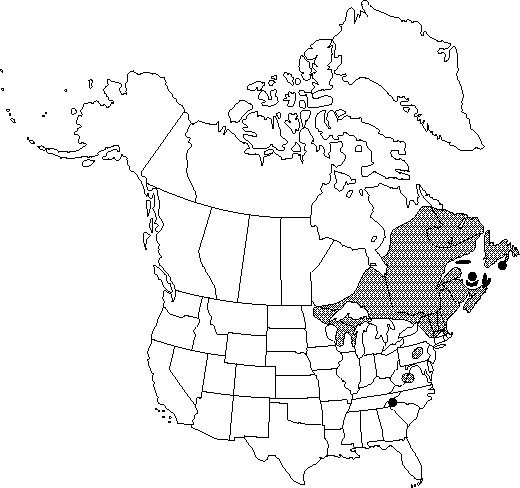Difference between revisions of "Betula cordifolia"
Nouv. Mém. Soc. Imp. Naturalistes Moscou 13(2): 86. 1861.
FNA>Volume Importer |
GeoffLevin (talk | contribs) m (Fixed Nfld. and Labr. distribution to match map in printed version.) |
||
| (3 intermediate revisions by 2 users not shown) | |||
| Line 35: | Line 35: | ||
|habitat=Moist, rocky slopes or rich, open forest | |habitat=Moist, rocky slopes or rich, open forest | ||
|elevation=800–2000 m | |elevation=800–2000 m | ||
| − | |distribution=St. Pierre and Miquelon;N.B.;Nfld.;N.S.;Ont.;P.E.I.;Que.;Maine;Mass.;Mich.;Minn.;N.H.;N.Y.;N.C.;Pa.;Vt.;Va.;W.Va.;Wis. | + | |distribution=St. Pierre and Miquelon;N.B.;Nfld. and Labr.;N.S.;Ont.;P.E.I.;Que.;Maine;Mass.;Mich.;Minn.;N.H.;N.Y.;N.C.;Pa.;Vt.;Va.;W.Va.;Wis. |
|discussion=<p><i>Betula cordifolia</i> has been reported from Connecticut; I have not seen specimens.</p><!-- | |discussion=<p><i>Betula cordifolia</i> has been reported from Connecticut; I have not seen specimens.</p><!-- | ||
--><p>In recent years <i>Betula cordifolia</i> has usually been treated as a variety of <i>B. papyrifera</i>, and perhaps it should be considered an ecological race of that species. It differs from <i>B. papyrifera</i> in polyploid level (diploid and tetraploid in <i>B. cordifolia</i> versus tetraploid, pentaploid, and hexaploid in <i>B. papyrifera</i>) and in vegetative characters, including the number of lateral veins of leaves and the color of bark (W. H. Brittain and W. F. Grant 1967; P. E. DeHond and C. S. Campbell 1989). In the Adirondacks, <i>B. cordifolia</i> and <i>B. papyrifera</i> occur in rather distinct ecological zones (<i>B. cordifolia</i> mostly above 800 m and <i>B. papyrifera</i> generally below this elevation). The species does not appear to occur as far west (Iowa) as stated by M. L. Fernald (1950).</p> | --><p>In recent years <i>Betula cordifolia</i> has usually been treated as a variety of <i>B. papyrifera</i>, and perhaps it should be considered an ecological race of that species. It differs from <i>B. papyrifera</i> in polyploid level (diploid and tetraploid in <i>B. cordifolia</i> versus tetraploid, pentaploid, and hexaploid in <i>B. papyrifera</i>) and in vegetative characters, including the number of lateral veins of leaves and the color of bark (W. H. Brittain and W. F. Grant 1967; P. E. DeHond and C. S. Campbell 1989). In the Adirondacks, <i>B. cordifolia</i> and <i>B. papyrifera</i> occur in rather distinct ecological zones (<i>B. cordifolia</i> mostly above 800 m and <i>B. papyrifera</i> generally below this elevation). The species does not appear to occur as far west (Iowa) as stated by M. L. Fernald (1950).</p> | ||
| Line 55: | Line 55: | ||
|habitat=Moist, rocky slopes or rich, open forest | |habitat=Moist, rocky slopes or rich, open forest | ||
|elevation=800–2000 m | |elevation=800–2000 m | ||
| − | |distribution=St. Pierre and Miquelon;N.B.;Nfld.;N.S.;Ont.;P.E.I.;Que.;Maine;Mass.;Mich.;Minn.;N.H.;N.Y.;N.C.;Pa.;Vt.;Va.;W.Va.;Wis. | + | |distribution=St. Pierre and Miquelon;N.B.;Nfld. and Labr.;N.S.;Ont.;P.E.I.;Que.;Maine;Mass.;Mich.;Minn.;N.H.;N.Y.;N.C.;Pa.;Vt.;Va.;W.Va.;Wis. |
|reference=None | |reference=None | ||
|publication title=Nouv. Mém. Soc. Imp. Naturalistes Moscou | |publication title=Nouv. Mém. Soc. Imp. Naturalistes Moscou | ||
|publication year=1861 | |publication year=1861 | ||
|special status=Endemic | |special status=Endemic | ||
| − | |source xml=https:// | + | |source xml=https://bitbucket.org/aafc-mbb/fna-data-curation/src/2e0870ddd59836b60bcf96646a41e87ea5a5943a/coarse_grained_fna_xml/V3/V3_92.xml |
|subfamily=Betulaceae subfam. Betuloideae | |subfamily=Betulaceae subfam. Betuloideae | ||
|genus=Betula | |genus=Betula | ||
Latest revision as of 14:11, 29 February 2024
Trees or shrubs, large, irregular, to 20 m; trunks often several, trees with narrow crowns. Bark of young trunks and branches dark reddish brown, close, in maturity reddish white to reddish tan or bronze, exfoliating in paper-thin sheets; lenticels dark, horizontally expanded. Twigs glabrous to sparsely pubescent, often covered with conspicuous, warty, resinous glands. Leaf blade narrowly ovate to ovate with 9–12 pairs of lateral veins, 6–10(–14) × 4–8 cm, base usually cordate, rarely rounded, margins coarsely or irregularly doubly serrate, apex short-acuminate, abaxially sparsely to moderately pubescent, sometimes velutinous or tomentose along major veins and in vein axils, covered with minute, resinous glands. Infructescences pendulous or nearly pendulous, cylindric, 2.5–5.5 × 0.6–1 cm, shattering with fruits in fall; scales glabrous to moderately pubescent, lobes diverging proximal to middle, central lobe elongate, obtuse, lateral lobes ascending, shorter and slightly broader than central lobe. Samaras with wings broader than body, broadest near summit, extended beyond body apically. 2n = 28, 56.
Phenology: Flowering late spring.
Habitat: Moist, rocky slopes or rich, open forest
Elevation: 800–2000 m
Distribution

St. Pierre and Miquelon, N.B., Nfld. and Labr., N.S., Ont., P.E.I., Que., Maine, Mass., Mich., Minn., N.H., N.Y., N.C., Pa., Vt., Va., W.Va., Wis.
Discussion
Betula cordifolia has been reported from Connecticut; I have not seen specimens.
In recent years Betula cordifolia has usually been treated as a variety of B. papyrifera, and perhaps it should be considered an ecological race of that species. It differs from B. papyrifera in polyploid level (diploid and tetraploid in B. cordifolia versus tetraploid, pentaploid, and hexaploid in B. papyrifera) and in vegetative characters, including the number of lateral veins of leaves and the color of bark (W. H. Brittain and W. F. Grant 1967; P. E. DeHond and C. S. Campbell 1989). In the Adirondacks, B. cordifolia and B. papyrifera occur in rather distinct ecological zones (B. cordifolia mostly above 800 m and B. papyrifera generally below this elevation). The species does not appear to occur as far west (Iowa) as stated by M. L. Fernald (1950).
Selected References
None.